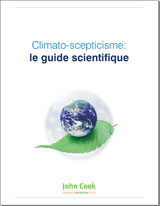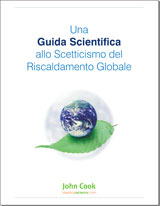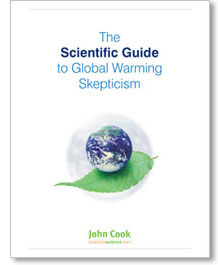The Scientific Guide to Global Warming Skepticism
Posted on 8 December 2010 by John Cook
Note: Please be aware that the Scientific Guide to Skepticism was first published in December 2010 and that the information presented is therefore - at least in some places - no longer completely current. As a rewrite and update of the guide (not to mention its many translations!) is not really feasible, please check the links provided further down on this page leading to additional and more up to date information.
Scientific skepticism is healthy. In fact, science by its very nature is skeptical. Genuine skepticism means considering the full body of evidence before coming to a conclusion. However, when you take a close look at arguments expressing climate ‘skepticism’, what you often observe is cherry picking of pieces of evidence while rejecting any data that don’t fit the desired picture. This isn’t skepticism. It is ignoring facts and the science.
The Scientific Guide to Global Warming Skepticism looks at both the evidence that human activity is causing global warming and the ways that climate ‘skeptic’ arguments can mislead by presenting only small pieces of the puzzle rather than the full picture.

The Guide explains the science in brief, plain language without getting too technical. For those who wish to dig deeper into the science, more detailed treatments can be found at the following pages (often presented with varying levels of complexity from Basic to Advanced):
- Human CO2 emissions is tiny compared to natural emissions
- Global warming stopped in 1998
- It's cooling
- Climate sensitivity is low
- Climate has changed in the past
- CO2 lags temperature
- CO2 doesn't cause much warming
- The warming trend is due to microsite influences
- The temperature record is unreliable
- The hockey stick is broken
- Global warming is a good thing
- Climategate shows there's a conspiracy among climate scientists
- There's no scientific consensus
How people are using the Guide
The Guide is being used by teacher associations, museums, websites, student groups and other organisations. Read some of the examples of how the Guide is being used.
Translations
Since its initial publication, The Guide has been translated into the languages shown below, but no further translations are planned, due to the content being based on information from 2010 and earlier (see green box at the top). If you are interested in helping with other translations, please check this blog post explaining active translation activities as of February 2022.
Czech |
Chinese (Traditional) |
Croatian |
||
Dutch |
Finnish |
French |
||
German |
Icelandic |
Indonesian |
||
Italian |
Luxembourgish |
Norwegian |
||
Polish |
Portuguese |
Slovak |
||
Slovenian |
Spanish |
Swedish |
||































 Arguments
Arguments
































Sorry, that's the best I can do at the moment :-)
The human fingerprint in the daily cycle
During the day, the sun warms the Earth's surface. At nighttime, the surface cools by radiating its heat out to space. Greenhouse gases slow down this cooling process. This is why deserts cool so much at night. Water vapour is a strong greenhouse gas and the dry desert air traps much less heat than more humid areas. A more extreme example is the moon which has no atmosphere. At nighttime, there are no greenhouse gases to trap the outgoing heat. Consequently, the difference between day and night is more extreme with daytime temperatures getting up to around 118°C and nighttime temperatures falling below -168°C. In other words, the stronger the greenhouse effect, the smaller the difference between daytime and nighttime temperatures.
The human fingerprint in the seasons
During summer, a region receives more sunlight and warms. During winter, the region receives less sunlight and cools by radiating heat to space. Greenhouse gases stop some of this heat from escaping to space so an increased greenhouse effect slows down the winter cooling. Consequently, if greenhouse gases are causing global warming, we expect to see winters warming faster than summer.
To be precise, it's primarily visible light that warms the Earth's surface. UV light is mostly absorbed by the ozone layer.
But it is true, her work looks damn good. :-)
CO2 in the ocean is going up. The ocean is building up CO2 because it's absorbing much of the CO2 we're emitting. But as the ocean warms, it's ability to absorb CO2 is lessening. So we are seeing more of our CO2 emissions remain in the atmosphere each year (the airborne fraction). The trend in the airborne fraction is slight, teetering on statistical significance.
"I’m fascinated by that graph of increasing ocean heat energy. I’m also confused by its seeming variability. Why is it going up in such a stagger?"
I haven't discussed this with Dan Murphy, author of the paper where that graph came from, but my speculation is the variability in the ocean heat graph is because he calculates total ocean heat from the upper ocean heat content. Upper ocean heat shows more variability compared to the total ocean heat calculated to greater depths because the upper ocean exchanges heat with the deeper layers. This is why when you see graphs of heat over 0 to 700 metres, the heat content jumps up and down while graphs of heat down to 2000 metres deep show a more monotonic increase in heat.
To calculate ocean heat back to 1950, Murphy had to use ocean data calculated from measurements of the upper ocean. To extrapolate this to deeper waters, he used studies that found the heat accumulating in the deep ocean was around 30% of the heat accumulating in the upper ocean. Thus if he'd have had access to direct ocean heat measurements down to the abyssal depths, I'm guessing the ocean heat graph would've shown less year to year variability. That's just speculation on my part.